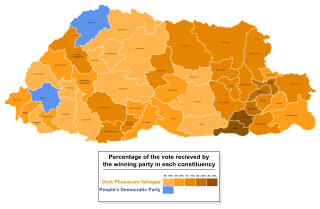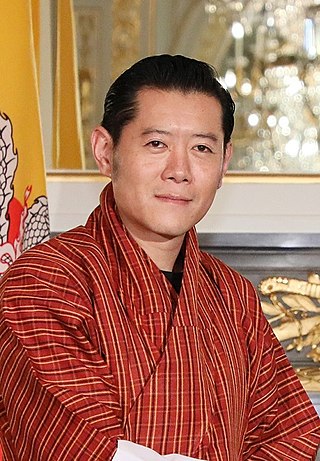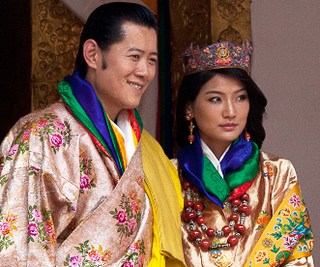Related Research Articles

Bhutan's early history is steeped in mythology and remains obscure. Some of the structures provide evidence that the region has been settled as early as 2000 BC. According to a legend it was ruled by a Cooch-Behar king, Sangaldip, around the 7th century BC, but not much is known prior to the introduction of Tibetan Buddhism in the 9th century, when turmoil in Tibet forced many monks to flee to Bhutan. In the 12th century, the Drukpa Kagyupa school was established and remains the dominant form of Buddhism in Bhutan today. The country's political history is intimately tied to its religious history and relations among the various monastic schools and monasteries.

Print circulation is the average number of copies of a publication. The number of copies of a non-periodical publication are usually called print run. Circulation is not always the same as copies sold, often called paid circulation, since some issues are distributed without cost to the reader. Readership figures are usually higher than circulation figures because of the assumption that a typical copy is read by more than one person.

"Druk Tsenden" is the national anthem of Bhutan. Adopted in 1953, the lyrics were written by Dolop Droep Namgay and possibly translated into English by Dasho Gyaldun Thinley. The accompanying music was composed by Aku Tongmi.

The national flag of Bhutan is one of the national symbols of Bhutan. The flag features a Chinese dragon from Bhutanese mythology. This alludes to the Dzongkha name of Bhutan – Druk Yul – as well as the Drukpa Lineage of Tibetan Buddhism, which is the dominant religion of Bhutan.

Paro District is a district (dzongkhag), valley, river and town in Bhutan. It is one of the most historic valleys in Bhutan. Both trade goods and invading Tibetans came over the pass at the head of the valley, giving Paro the closest cultural connection with Tibet of any Bhutanese district. The dominant language in Paro is Dzongkha, the national language.
Kuensel is the national newspaper of the Kingdom of Bhutan. It was the only local newspaper available in Bhutan until 2006 when two more newspapers were launched. The government of Bhutan owns 51% of Kuensel while 49% is held by the public.

Penlop is a Dzongkha term roughly translated as provincial governor. Bhutanese penlops, prior to unification, controlled certain districts of the country, but now hold no administrative office. Rather, penlops are now entirely subservient to the House of Wangchuck.
The various mass media in Bhutan have historically been government-controlled, although this has changed in recent years. The country has its own newspapers, television and radio broadcasters and Internet Service Providers.

National Assembly elections were held in Bhutan for the first time on 24 March 2008. Two parties were registered by the Election Commission of Bhutan to contest the elections; Druk Phuensum Tshogpa, led by Jigme Y. Thinley, which was formed by the merger of the Bhutan People's United Party and All People's Party, and the People's Democratic Party (PDP). A third political party, the Bhutan National Party (BNP), had its application for the registration refused.

The Bhutan Observer was Bhutan's first private bilingual newspaper. It was launched as a private limited company by parent company Bhutan Media Services (BMS), and began publishing on June 2, 2006, in Thimphu. Its Dzongkha edition was called Druk Nelug, and the newspaper maintained an online service in English until 2013.
The development of Bhutanese democracy has been marked by the active encouragement and participation of reigning Bhutanese monarchs since the 1950s, beginning with legal reforms such as the abolition of slavery, and culminating in the enactment of Bhutan's Constitution. The first democratic elections in Bhutan began in 2007, and all levels of government had been democratically elected by 2011. These elections included Bhutan's first ever partisan National Assembly election. Democratization in Bhutan has been marred somewhat by the intervening large-scale expulsion and flight of Bhutanese refugees during the 1990s; the subject remains somewhat taboo in Bhutanese politics.
The Druk Desi was the title of the secular (administrative) rulers of Bhutan under the dual system of government between the seventeenth and nineteenth centuries. Under this system, government authority was divided among secular and religious administrations, both unified under the nominal authority of the Zhabdrung Rinpoche. Druk, meaning 'thunder dragon', refers symbolically to Bhutan, whose most ancient name is Druk-yul. Desi, meaning 'regent', was the chief secular office in the realm under this system of government.

The Druk Gyalpo is the head of state of the Kingdom of Bhutan. In the Dzongkha language, Bhutan is known as Drukyul which translates as "The Land of the Thunder Dragon". Thus, while kings of Bhutan are known as Druk Gyalpo, the Bhutanese people call themselves the Drukpa, meaning "people of Druk (Bhutan)".

The Supreme Court of Bhutan (དངོན་མཐོ་ཁྲིམས་འདུན་ས།) is the Kingdom of Bhutan's highest court of review and interpreter of the Constitution.
The national symbols of Bhutan include the national flag, national emblem, national anthem, and the mythical druk thunder featured in all three. Other distinctive symbols of Bhutan and its dominant Ngalop culture include Dzongkha, the national language; the Bhutanese monarchy; and the driglam namzha, a seventeenth-century code on dress, etiquette, and dzong architecture. Natural symbols of Bhutan are its national flower, the Himalayan blue poppy; its national tree, the Himalayan cypress; its national bird, the raven; and its national animal, the takin.
Public holidays in Bhutan consist of both national holidays and local festivals or tshechus. While national holidays are observed throughout Bhutan, tsechus are only observed in their areas. Bhutan uses its own calendar, a variant of the lunisolar Tibetan calendar. Because it is a lunisolar calendar, dates of some national holidays and most tshechus change from year to year. For example, the new year, Losar, generally falls between February and March.

The wedding of Jigme Khesar Namgyel Wangchuck, King of Bhutan, and Jetsun Pema took place on 13 October 2011 at the Punakha Dzong in Punakha, Bhutan. The current King of Bhutan, Jigme Khesar Namgyel Wangchuck, married Jetsun Pema, who became Queen Ashi Jetsun Pema Wangchuck. Both are descendants of the 48th Druk Desi of Bhutan and 10th Penlop of Trongsa, Jigme Namgyal.

Jetsun Pema is the Druk Gyaltsuen of Bhutan, as the wife of King Jigme Khesar Namgyel Wangchuck. She is currently the youngest queen consort in the world. She and the King have three children: Jigme Namgyel, the heir apparent to the Bhutanese throne, Jigme Ugyen, and Sonam Yangden.

The Bhutan Centre for Media and Democracy (BCMD) is the first Civil Society Organisation in Bhutan. It was launched in 2008 coinciding with the country's first government elections, which heralded a new era of self-governance following the abdication of the fourth king of Bhutan, Jigme Singye Wangchuck. At the same time, the media landscape saw the arrival of new private newspapers and radio stations, as well as social media via mobile telephones and the Internet. The stated mission of BCMD is to "nurture democracy in Bhutan through civic engagement, public discourse and media literate citizens".
References
- ↑ "IPA Journal" . Retrieved 22 November 2011.
- ↑ Ura, Karma. "AN ASSESSMENT OF DEMOCRACY" (PDF). GNHC. Archived from the original (PDF) on 25 April 2012. Retrieved 22 November 2011.